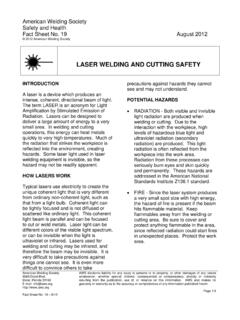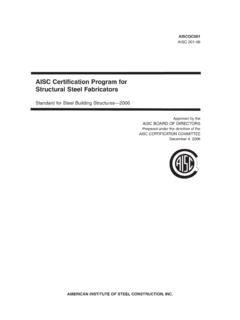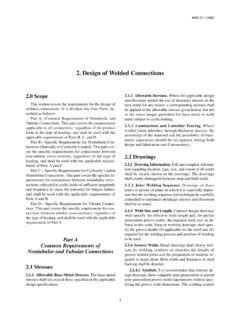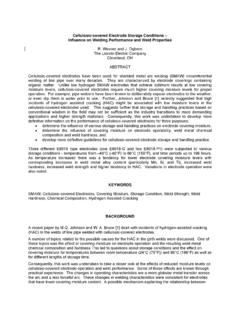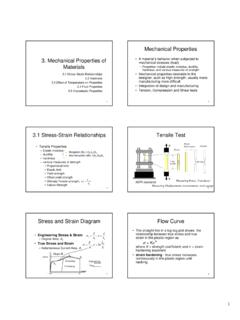Transcription of PRACTICAL HARDNESS TESTING MADE SIMPLE
1 PRACTICAL HARDNESS TESTING made SIMPLE iTable of ContentsPage1. GENERAL 12. INTRODUCTION 33. BRINELL HARDNESS TESTING 94. VICKERS HARDNESS TESTING 145. ROCKWELL HARDNESS TESTING 176. INFORMATIONS 22 PRACTICAL HARDNESS TESTING made SIMPLE 11. GENERALI mportant facts and features to be known and booklet intends to stress the significance ofHardness TESTING and to dispel a few commonmisconceptions attributing to it inappropriate meanings is dedicated to all people using HARDNESS TESTING intheir daily work, for them to be aware of the usefulness of themethods, when applied correctly, and of the dangers of faultygeneralisations, if interpreted outside the frame of may also be useful for students learning to practiceHardness TESTING .
2 To orient them in the understanding of abroader meaning of the results information appearing in the following pages canbe found in the best Handbooks dealing with the subjectmatter. As these may or may not be readily available to theinterested persons, the material included is presented herefollowing the personal experience and preference of : the information, given herewith in good faith forenlarging the understanding of quite common a TESTING , isbelieved to be correct at the time of this writing, fruit oflongtime practice with actual operations in an HARDNESS TESTING made SIMPLE 2 Nothing written here though should be construed asauthority to use the results for reaching conclusions bearingdirect influence on possible harming of people or loss ofmaterial do so at their own entire risk.
3 No responsibility isaccepted for any action taken or witheld as a consequence ofthe information submitted HARDNESS TESTING made SIMPLE 32. INTRODUCTIONFor Metallurgists, HARDNESS TESTING is a collection ofdifferent methods for measuring a definite characteristic ofmetallic materials, namely:a) the resistance to penetration of a specific Indenter(defined by fixed form and properties),b) under the application of a certain static forcec) for a definite time,d) using precise measuring result, usually expressed by a number or by a rangeof numbers, must be qualified by an accepted conventionindicating exactly by which one of the possible methods suchresult was so defined is not an intrinsic property of anymaterial, (like density or melting point)
4 , it is rather acharacteristic deriving from the composition, the thermal andmechanical history of the material, and essentially from thestructure (or more properly the microstructure) of thespecimen variety of methods and conditions developed forhardness TESTING is a consequence of the fact that no singlemethod can cover all the possible degrees of the methods employed are empirical, in the sensethat they were developed by trial and error to satisfy a need,and that they knew their enormous diffusion due to theirintrinsic HARDNESS TESTING made SIMPLE 4It is commonly believed that, for PRACTICAL purposes, ina definitely limited range.
5 There is an approximatecorrespondence between HARDNESS data and a range of tensilestrength this assumption is generally correct if taken withdue caution, one must remember that no indication regardingductility is obtained through HARDNESS long practice of application of different methods oftesting has produced a wealth of data which has permitted thecomparison of values obtained on the same E 140, Standard HARDNESS Conversion Tablesfor Metals, (for information on where to find, see at the endof this publication) is the best known and authoritative however should be applied when intending touse the comparison, making sure that it is valid for thematerial in question, (hard steel, soft steel, nickel alloys,magnesium alloys, brass, aluminum alloys) and keeping inmind that in any case it is only an specialists in different disciplines, HARDNESS mayhave different meanings, which should not concern us here,except for a very common misconception, generally believedby people involved in machining using metal removal by acutting tool, where HARDNESS is held as an indication of theease or difficulty of chip removal.
6 In certain cases it is not HARDNESS TESTING made SIMPLE 5 Examples:1) - Extremely difficult to machine materials, likeaustenitic stainless steels or heat resisting alloys, havequite normal medium range hardnesses, which give nohint to the elevated forces involved in the process ofdeforming and tearing chips out of the ) - On the other hand free machining stainless steelswhere appropriate elements like Sulfur or Seleniumwere added to their composition in order to break upthe chips, present the same medium range HARDNESS ,without revealing their most important TESTING , as defined above: is inexpensive, non destructive, easy to implement with properly calibrated equipment, by operators who can easily be trained and supervised, applying understandable written procedures strictlymaintained, and gives useful information if it is known what particular it is a very useful tool for process controland for materials acceptance, if performed , and this is the danger, it is often taken for grantedwith no further one must always keep in mind that the test islocalised, that it is true only on the spot where it wasdetermined.
7 One cannot assume that it is valid for all thePRACTICAL HARDNESS TESTING made SIMPLE 6volume unless one can be sure that the material ishomogeneous (the same everywhere) and that the mechanicaland thermal processes produced uniform results. This is themost usual cause of erroneous conclusions derived whileoverlooking the origins of unaccounted for HARDNESS readings will NOT represent truethrough HARDNESS when: plating by a different element ( Chromium) ispresent a plasma or thermal-sprayed layer was deposited the specimen is decarburised (having lost Carbon) onthe surface case hardening was performed (carburising, inductionor flame hardening, nitriding etc.)
8 Welding or flame cutting was done nearby a recast layer, produced by electrodischargemachining, is present local strain (deformation) hardening like disc cuttingtook place on the tested surface or nearby surface improvement process like shot peening ispresent the part has widely varying (thick and thin) sectionswhere response to heat treatment may be different the surface was abusively treated ( by uncontrolledgrinding) producing local overheating there is reason to suspect that HARDNESS is not constantthrough the thickness of HARDNESS TESTING made SIMPLE 7 Furthermore an erroneous HARDNESS reading can easilybe obtained if the correct rules of application of the specificmethod involved are not one should always check if the methodselected is appropriate for the results sought for and if the testwas applied correctly by a knowledgeable operator, withproperly maintained and calibrated complete Calibration of a HARDNESS Testingmachine, which should be performed at least annually.
9 Consists in the direct verification of each of its importantfeatures, including the actual value of the applied force usingcalibrated load cells or other specialized normal operation one must perform, as requiredby Recommended Practices, a daily HARDNESS check on aReference Block of known HARDNESS . This is an indirectverification, to ensure that the TESTING machine provides thecorrect result reported for the Blocks, also known as HARDNESS TestBlocks, are manufactured to have the most homogeneoushardness on all of their surface, an their nominal hardnesswas determined with utmost care at the origin. Any deviationfrom the standard result requires a thorough overhaul andsystematic check and calibration of the Blocks should be treated as most preciousaccessories for controlling the quality of routine hardnesstesting: as such they must be obtained from reputable sourceswith a signed HARDNESS TESTING made SIMPLE 8 HARDNESS Reference Blocks.
10 Must be kept clean in an environment where they willnot rust and will not be exposed to excessive heat (which couldchange their properties) They must be used only on their polished face (neveron the opposite one) The impressions must be far from edges and from oneanother (at least three times their size) No attempt should be made to reclaim them bygrindingIn the following only the most important TESTING methodsalong with their rules shall be recalled and explained. Othermethods exist, each one with its particular niche ofapplicability and usefulness, but on purpose we leave themout of this HARDNESS TESTING made SIMPLE 93.
